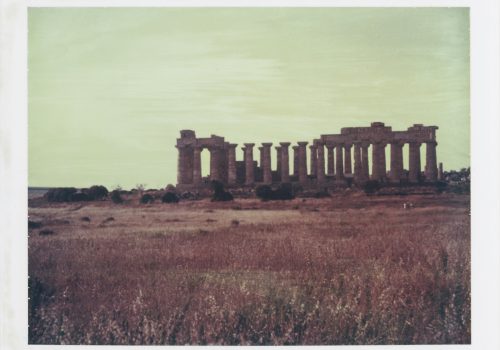This is not a text on François Halard that portrays him as an interior or decor photographer. This simplistic view of the photographer’s work is contradicted by Oscar Humphries, who is revealing a series unknown until now in the book Italian Polaroids by Idea Books and Sotheby’s.
Throughout the pages, the reader discovers new images accompanied by short texts written by François Halard like in a logbook. It was the end of his adolescence that he discovered Italy’s oneiric dimension during a trip which had left him with a memory of sheer amazement. Since the 1980s, the photographer traveled through Italy, like Pasolini in The Long Road of Sand, to recreate his own Grand Tour. The publication Italian Polaroids offers the reader a dream-like Italy, pristine, where time seems suspended. At the time of dematerialization, François Halard remained loyal to the square format of the Polaroid 669, which had the peculiarity of being a photography process where one had to shoot and develop the Polaroids themselves in one minute.
Far more than a simple technique, the Polaroid had a profound influence on photography. Used by Andy Warhol, David Hockney, and even Patti Smith, Polaroids piqued the interest of artists in the 1960s. In the 1970s, the Polaroid technique, characterized by its unique printing, participated in legitimizing photography in art history. François Halard especially considered the Polaroid like a full-fledged art, a perspective on the present. The photographer was seduced by this slightly cumbersome camera, easily transportable, and by the rendering of colors of the 669’s film. Though the Polaroids were willingly used by photographers like Ansel Adams and Robert Frank to test the light and framing of film prints, François Halard’s images are not only steps towards creation. He documented historic places such as Bomarzo’s Park of the Monsters where the light and close-ups reveal the artist’s eye.
At first glance, it is difficult to date François Halard’s Polaroids. Other than the use of color, the proofs call back to the photographic landscapes of the first illustrated books of the 19th century. The grain, the pigment, the blurred effect of the Polaroids accentuate the timeless dimension of the images. In his representations of the vestiges of the citadel of Selinunte in Sicily, the Polaroids evoke the vedute of Giovanni Panini. A pictorial genre appearing in the 18th century, the vedute are small format landscape paintings that represent composed views of Italy’s citadels and archeological sites. With his camera, François Halard created exterior views of Selinunte where the rendering of colors gave the Polaroids the look of watercolors. Developed in a chromatic field of reds, the prints representing the temple become the marks of time where the photographic medium substitutes its testimony for the photographer’s memory.
Apart from a self portrait in the mirror and two portraits of Cy Twombly in his garden, the human is practically absent from the photographs. François Halard concentrates on the representation of objects and their environment like still life paintings that evoke humanity without depicting it. By discovering images of François Halard’s house in the center of Arles, we notice an analogy between his interior photographs and where he lives. The photographer uses his camera like a tool to recreate his own universe. His home in Arles, populated with a multitude of different objects, can appear like a film photograph negative. His heart is set on his dream role: the distinguished inventor of a cabinet of curiosities. The Polaroids are personal reminisces to which are attached an almost religious sense. Once printed, the images become, in turn, relics: “I carefully preserve all my blank Polaroids in the refrigerators at my home,” said the photographer in an interview. Similarly, in his images of the sumptuous Casa Mollino in Turin, photography preserves a type of partnership with the staged space. The prints seem to come right from the filming of The Leopard by Visconti.
François Halard conceived his own scenography by capturing art objects, colored tapestries, moldings, and mirrors that decorated the space. At the Villa Malaparte, built on a rocky mountainside in Capri, his photographic work exceeded the simple recording of reality. Here, the choice of black and white accentuated the lines of the architectural work conceived by Adalberto Libero. He created the impressive views of the Villa to reveal the inverted pyramid stairs and the solarium roof – the famous set of Godard’s Contempt. One can find even more cinematic references in François Halard’s photographic work. The ruins of Hubert Robert via the texts of Stendhal in Italy or even in the films of Antonioni, François Halard’s camera remains the reflection of his own sensibility. With the images that live in his memory, he is offering, in this publication, a hymn to the beauty that makes Italy’s light vibrate.
Isabella Seniuta
Isabella Seniuta is an author specialized in photography and a doctoral candidate in art history at the Paris-Sorbonne University.
François Halard, Italian Polaroids
Published by Idea Books and Sotheby’s
£35
















